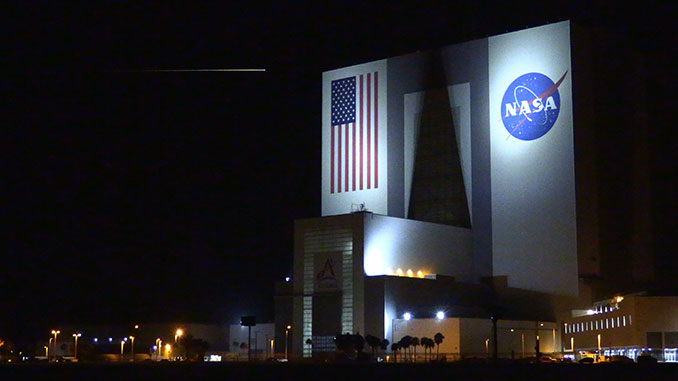
Safely splashes down east of Jacksonville by Crew Dragon
- Science
- September 5, 2023
A SpaceX Crew Dragon spaceship took four space station travellers down to Earth early Monday, splashing down in the Atlantic Ocean east of Jacksonville to end their six-month tenure in orbit. The spacecraft was seen blazing like a shooting star as it rocketed high above northern Florida.
In order to begin their 17-hour journey down to Earth, Crew-6 commander Stephen Bowen, pilot Woody Hoburg, cosmonaut Andrey Fedyaev, and UAE crewmate Sultan Alneyadi undocked from the station’s forward Harmony module at 7:05 a.m. EDT on Sunday.
Starting at 11:24 p.m., the automated Crew Dragon launched a 16-minute de-orbit engine fire, slowing the spacecraft by roughly 250 mph and lowering it back into the lower atmosphere for a sharp southwest-to-northeast course that would take it above Central America and north Florida.
The Crew Dragon was engulfed in a cloud of super-heated plasma, slowing from orbital velocity of 17,100 mph to just 300 mph in a matter of minutes, and from the Kennedy Space Centre, the returning spacecraft appeared to be a slow-motion meteor leaving a long, brilliant trail across the sky.
The capsule’s four main parachutes deployed on schedule, inflated, and brought the spacecraft down to a graceful splashdown in light wind and five-foot seas off Florida’s east coast at 12:17 a.m. with SpaceX recovery teams and NASA observers watching from the sidelines.
“On behalf of NASA and SpaceX, welcome back home,” SpaceX radioed from the California rocket builder’s control center. “Thank you for flying SpaceX.”
“We greatly appreciate all the support, from all the initial training, to the launch, throughout the mission … this has been incredible,” Bowen replied. “We certainly appreciate it and look forward to working with you all again.”
Within minutes of the Crew Dragon’s splashdown, SpaceX crews arrived. Cables were attached, the spacecraft was lowered onto the SpaceX rescue ship, and any fuel vapours were checked for.
To ease the first rigours of readjusting to the unfamiliar drag of gravity, recovery specialists brought Bowen and company out of the Crew Dragon one at a time as is customary with long-duration flights and placed them on rolling recliners.
Former submariner Bowen expressed his excitement for “the nice ocean air and peaceful calm seas” before leaving the space station. It will be wonderful to return to that.
Hoburg stated that he was anticipating “a real shower.” Alneyadi expressed his eagerness to see his loved ones once more and to resume enjoying life. “a real hot cup of coffee.” As for Fedyaev, “I think my dream is a bed for good sleeping. I can lay on one side. Another side. My back. Sleeping!”
All four pilots were to be transported to land by helicopter following initial medical evaluations on board the recovery ship. In Jacksonville, a NASA jet was waiting to take them back to Houston and the Johnson Space Centre for a debriefing, additional medical examinations, and reunifications with loved ones.
Three Soyuz crew members — station commander Sergey Prokopyev, Dmitri Petelin, and NASA astronaut Frank Rubio — were left in space, and four Crew Dragon aircraft launched on August 26 to take their places: Commander of Crew-7 Jasmin Moghbeli, astronaut Andreas Mogensen of the European Space Agency, astronaut Satoshi Furukawa of Japan, and cosmonaut Konstantin Borisov.
Prokopyev, Petelin, and Rubio completed a gruelling 371-day mission after being launched to the station in September of last year.
They had intended to stay in space for six months, but last December, a significant coolant leak on their Soyuz transport spacecraft prevented them from doing so. The crew’s mission was prolonged by an additional six months when the Russians made the decision to launch a replacement spacecraft.
On September 15, a brand-new Soyuz crew consisting of the commander Oleg Kononenko, Nikolai Chub, and NASA astronaut Loral O’Hara is planned to launch from the Baikonur Cosmodrome in Kazakhstan.
After 12 days, Prokopyev, Petelin, and Rubio will undock and return to Earth. Rubio will accomplish this in order to achieve a new American record for the longest single mission by an astronaut.
The Crew-6 astronauts, who were launched on March 2 aboard a SpaceX Falcon 9 rocket, orbited the earth 2,976 times while travelling 78.9 million miles across space during their 185 days and 22 hours in space. Bowen, the sole space veteran on the crew, had spent 227 days in orbit over four missions at the time of splashdown.
Seven visitors arrived during Crew-6’s journey, including two unmanned Cargo Dragon spacecraft, two Russian Progress supply ships, a Northrop Grumman Cygnus cargo carrier, and two crewed Crew Dragon spacecraft.
They performed three spacewalks as well. Bowen and Hoburg went outdoors on two separate occasions to install fresh roll-out solar blankets, while Alneyadi went outside with Bowen on a third occasion to retrieve a broken antenna package and perform other maintenance.
“It’s certainly been the experience of a lifetime, and a real honor to get to spend six months, six incredibly short-feeling months, living and working aboard this incredible orbiting outpost,” Hoburg said before departing the station. “I think we got a lot done.”